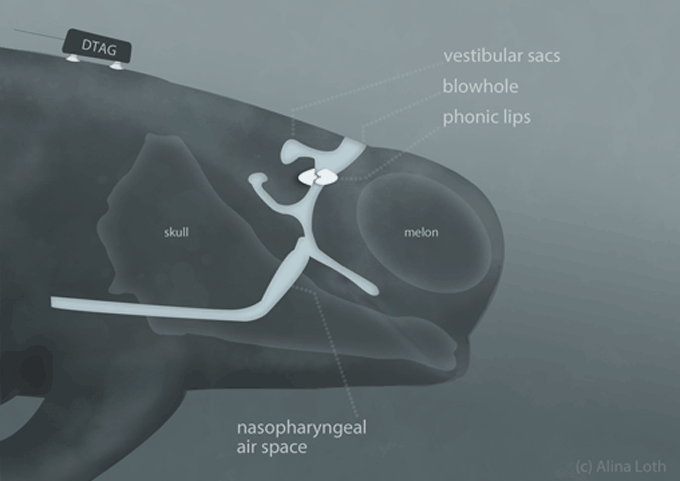Whales echolocate with big clicks and tiny amounts of air
This shows whales need little energy to sense what’s in their environment

Audio recorders stuck by suction cups onto the backs of pilot whales let scientists snoop on the sonar-like sounds the whales make to echolocate. Those data suggest whales efficiently make powerful clicks — with miniscule amounts of air.
Dmitry Kokh/iStock/Getty Images Plus
Some whales dine in the oceans’ depths. Too bad scientists can’t swim beside them. But tag-along audio recorders can snoop on the sounds these animals make. Thanks to such audio, scientists now have the best glimpse yet at how toothed whales use sonar-like clicks to sound out prey during their long dives. Toothed whales include orcas and other dolphins, sperm whales and pilot whales.
An analysis of more than 27,000 sounds from deep-diving pilot whales suggests that these whales use tiny volumes of air to produce powerful clicks. This suggests the whales’ use of those sonar-like clicks for echolocation (Ek-oh-loh-KAY-shun) takes little energy. Researchers shared these new findings October 31 in Scientific Reports.
Like humans, whales are mammals. But they have “found ways to survive in an environment that is extremely alien to us,” observes Ilias Foskolos. He works at Aarhus University in Denmark. As a bioacoustician (By-oh-ah-koo-STIH-shun), he studies the sounds animals make. Just as land-dwelling mammals do, whales make sounds by moving air in their bodies. “It’s something they’ve inherited from their terrestrial ancestors,” he says. But using air this way really limits an animal that hunts hundreds of meters below the waves, he says.
How whales continuously make clicks during their long, deep dives had been a mystery. So Foskolos and his team stuck recorders onto whales with suction cups. This allowed them to eavesdrop on the clicking whales.
They sometimes heard ringing tones in those clicks, notes Coen Elemans, who was not part of the study. From those ringing tones, he points out, the researchers “could estimate the volume of air in the whale’s head.” Elemans works at the University of Southern Denmark in Odense. There, he studies the physics of how animals make sound.
Elemans now compares the whales’ click-related rings to the tone someone hears when blowing air over the top of an open bottle. Its pitch will depend on how much air was in the bottle, he explains. Similarly, the ringing in the whale’s click relates to the amount of air inside an air sac within the whale’s head. The pitch of that ring changes as the whale clicks away, using up the air in the sac.
By analyzing click after click after click, the scientists found that to make a click at depths of 500 meters (1,640 feet), the whales may use as little as 50 microliters of air — the volume of a drop of water.
Air for now, air for later
Most of what scientists know about whale echolocation, Foskolos says, came from a 1983 study. It involved a captive dolphin. Back then, scientists learned that whales make clicks by moving air from the air sac through structures known as phonic lips. Like vocal cords, these “lips” control air flow. The “clicked” air ends up in another cavity in the head known as a vestibular (Ves-TIB-yoo-ler) sac.

The pressure at ocean depths of hundreds of meters compresses air. It shrinks air to a tinier volume than it takes up at the surface. Using a lot of air to echolocate would use a lot of energy to move it around. But the team’s new calculations find that the tiny volumes of air per click mean that a dive’s worth of clicks would cost a whale around 40 joules (JOO-uls). That’s a unit of energy. To put that number in perspective, it takes some 37,000 joules for a whale to submerge its buoyant body to a depth of 600 meters (about 2,000 feet). So echolocation is “a very efficient sensory system,” Foskolos concludes.
The scientists also noticed pauses in the whales’ echolocation. That didn’t make sense, Foskolos says. If a whale stops clicking, it might miss an opportunity to snag a squid or some other meal. While the whales paused those clicks, the team heard a sound like a person sucking in air. “They were actually sucking all the air back in [to the air sac],” he says. So instead of surfacing to inhale more air, the whales recycled the “clicked” air to make more clicks.
Because it’s hard to study these animals deep in the ocean, scientists know little about how whales echolocate, Elemans notes. Scientists have wondered if whales echolocate differently when loud noises, like those from boats, are present. But scientists first need to understand how echolocation works. “This study really narrows down the possibilities of how the whales make sounds,” he says.







